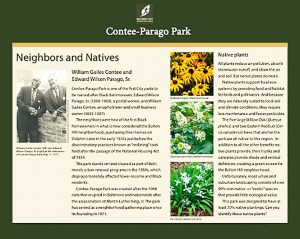
This spring will see a completely revitalized Contee-Parago Park, located on the southern end of Bolton Hill at the end of Bolton Street, with new seating, new signage and over 1,000 native plants.
A planting day scheduled for Saturday, May 7 will bring together neighborhood residents and volunteers from the Association of Professional Landscape Designers DC-MD-VA chapter (APLD). Non-native plants will be removed from the park and given away, and over 1,400 new plants will be installed. Mark this date on your calendars!
The planting day culminates a two-year effort in honor of the park’s 50th anniversary. Neighbors on the 1200 block of Bolton Street and Dolphin Lane have undertaken a renovation of the park to highlight its history and to give it new purpose.
Contee-Parago Park was established in 1971 and is likely the first park in the city named after Black citizens: William Gailes Contee (1891-1987) and Edward Wilson Parago, Sr. (1898-1983). The men and their families lived in Bolton Hill from the early 1930s – two of the first Black homeowners in the neighborhood. The family of Reese Culbreath, Parago’s grandson, still lives in a house on Dolphin Lane.
In a 1971 Baltimore Sun story about the park, Contee “modestly suggested” that it was named for him and Parago simply because they were “the oldest property-owners here.” While the statement was modest, it was not insignificant.
As historians and journalists have uncovered, Bolton Hill then was a locus for segregation efforts. Shortly before Contee and Parago purchased their homes on Dolphin Lane in the 1930s, a Sun article reported that Bolton Street residents successfully asked a court to bar what the Sun called “Negro invasions” – Black people moving just around the corner.
Just a few years after Contee and Parago purchased their homes, the National Housing Act of 1934 opened the door for redlining and other discriminatory practices that solidified segregation in Baltimore neighborhoods. In the 1960s, so-called “urban renewal” cleared Black neighborhoods, including houses on the land where Contee-Parago Park now stands.
In the 1971 Sun story, Contee confirms this, recalling “when Bolton Street was lined with houses, all the way down to Biddle Street.” Contee claimed that it was an “honor” to have the park named after him. Reading with hindsight, one wonders if his statement was tinged with irony. He continued, in a similar vein: “I like the people and they like me. . . . I was able to buy my house and educate my children.”
New signage to be installed in the park this month will place the park within this history, while also providing biographical details and a photograph of Contee and Parago. The original park plaque, currently hidden behind shrubbery near the entrance on the northeast corner of the park, will be installed in a more prominent location near the new sign.
Serra Stone Company will install a new seating area to replace the broken fountain installed in 1971. The large circular wall surrounding the eastern part of the park, near collapse for years from the growth of the large Willow Oak trees planted near it, has been taken to ground level. New brick piers will be installed to anchor the railings along the entrances and the remaining brick walls on the south side of the park.
Paved areas were removed last fall by Blue Water Baltimore – part of a $1.4 million National Fish and Wildlife Foundation grant to improve watershed health. These areas will be transformed into beds for new plantings of Maryland native plants. Using a plan developed by APLD, more than 70 percent of park plants will be native to the state. Native plants mitigate air pollution and stormwater runoff. They also provide food and habitat for birds, pollinators and other beneficial wildlife.
The new planting was inspired in part by the native Willow Oak trees. These trees have matured into lovely specimens that provide wonderful and welcome shade to a hot, sunny stretch of Dolphin Street, and also display beautiful yellow foliage in the fall. The Red Bud trees and Oakleaf Hydrangeas currently in the park are also native.
On the May 7 planting day, the new signage and seating areas will be unveiled. A commemoration celebration that will include the Contee and Parago families will be scheduled once pandemic conditions permit large gatherings.
The renovation required expensive infrastructural repairs and improvements to the park. The Friends of Contee-Parago Park are a few thousand dollars short of covering all costs. If you’d like to donate, please do so online at the BHCA website. Please designate the Contee-Parago Park renovation for the funds.
The Friends group also needs volunteers to join the maintenance crew. While native plants require less water and maintenance once established, they require regular care for two years following planting. If you are interested in neighborhood parks, native plants, birds or pollinators, and can spare a few hours this summer and fall, please contact Jean Lee Cole (jeanleecole@gmail.com) or Steve Oliner (stephen.oliner@gmail.com).
– Jean Lee Cole
